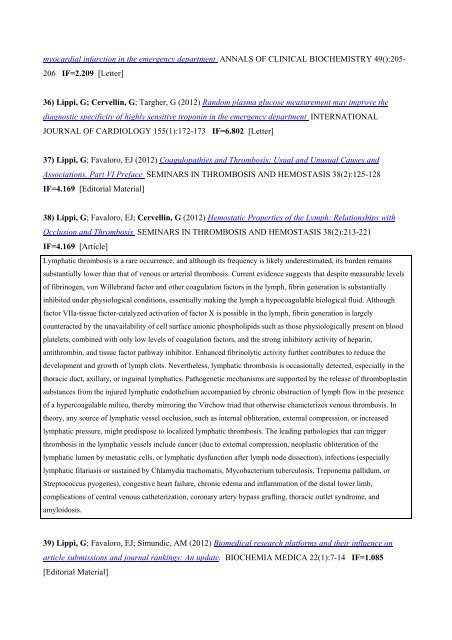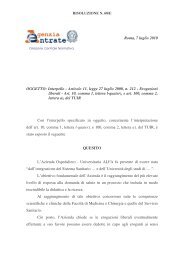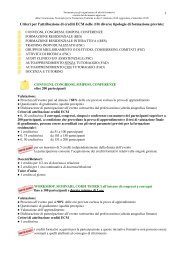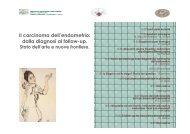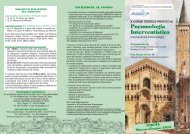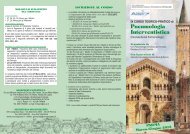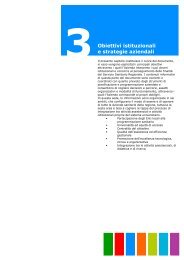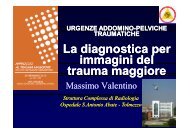COLLEGIO DI DIREZIONE - Azienda Ospedaliera di Parma
COLLEGIO DI DIREZIONE - Azienda Ospedaliera di Parma
COLLEGIO DI DIREZIONE - Azienda Ospedaliera di Parma
Create successful ePaper yourself
Turn your PDF publications into a flip-book with our unique Google optimized e-Paper software.
myocar<strong>di</strong>al infarction in the emergency department ANNALS OF CLINICAL BIOCHEMISTRY 49():205-<br />
206 IF=2.209 [Letter]<br />
36) Lippi, G; Cervellin, G; Targher, G (2012) Random plasma glucose measurement may improve the<br />
<strong>di</strong>agnostic specificity of highly sensitive troponin in the emergency department INTERNATIONAL<br />
JOURNAL OF CAR<strong>DI</strong>OLOGY 155(1):172-173 IF=6.802 [Letter]<br />
37) Lippi, G; Favaloro, EJ (2012) Coagulopathies and Thrombosis: Usual and Unusual Causes and<br />
Associations, Part VI Preface SEMINARS IN THROMBOSIS AND HEMOSTASIS 38(2):125-128<br />
IF=4.169 [E<strong>di</strong>torial Material]<br />
38) Lippi, G; Favaloro, EJ; Cervellin, G (2012) Hemostatic Properties of the Lymph: Relationships with<br />
Occlusion and Thrombosis SEMINARS IN THROMBOSIS AND HEMOSTASIS 38(2):213-221<br />
IF=4.169 [Article]<br />
Lymphatic thrombosis is a rare occurrence, and although its frequency is likely underestimated, its burden remains<br />
substantially lower than that of venous or arterial thrombosis. Current evidence suggests that despite measurable levels<br />
of fibrinogen, von Willebrand factor and other coagulation factors in the lymph, fibrin generation is substantially<br />
inhibited under physiological con<strong>di</strong>tions, essentially making the lymph a hypocoagulable biological fluid. Although<br />
factor VIIa-tissue factor-catalyzed activation of factor X is possible in the lymph, fibrin generation is largely<br />
counteracted by the unavailability of cell surface anionic phospholipids such as those physiologically present on blood<br />
platelets, combined with only low levels of coagulation factors, and the strong inhibitory activity of heparin,<br />
antithrombin, and tissue factor pathway inhibitor. Enhanced fibrinolytic activity further contributes to reduce the<br />
development and growth of lymph clots. Nevertheless, lymphatic thrombosis is occasionally detected, especially in the<br />
thoracic duct, axillary, or inguinal lymphatics. Pathogenetic mechanisms are supported by the release of thromboplastin<br />
substances from the injured lymphatic endothelium accompanied by chronic obstruction of lymph flow in the presence<br />
of a hypercoagulable milieu, thereby mirroring the Virchow triad that otherwise characterizes venous thrombosis. In<br />
theory, any source of lymphatic vessel occlusion, such as internal obliteration, external compression, or increased<br />
lymphatic pressure, might pre<strong>di</strong>spose to localized lymphatic thrombosis. The lea<strong>di</strong>ng pathologies that can trigger<br />
thrombosis in the lymphatic vessels include cancer (due to external compression, neoplastic obliteration of the<br />
lymphatic lumen by metastatic cells, or lymphatic dysfunction after lymph node <strong>di</strong>ssection), infections (especially<br />
lymphatic filariasis or sustained by Chlamy<strong>di</strong>a trachomatis, Mycobacterium tuberculosis, Treponema pallidum, or<br />
Streptococcus pyogenes), congestive heart failure, chronic edema and inflammation of the <strong>di</strong>stal lower limb,<br />
complications of central venous catheterization, coronary artery bypass grafting, thoracic outlet syndrome, and<br />
amyloidosis.<br />
39) Lippi, G; Favaloro, EJ; Simun<strong>di</strong>c, AM (2012) Biome<strong>di</strong>cal research platforms and their influence on<br />
article submissions and journal rankings: An update. BIOCHEMIA ME<strong>DI</strong>CA 22(1):7-14 IF=1.085<br />
[E<strong>di</strong>torial Material]


